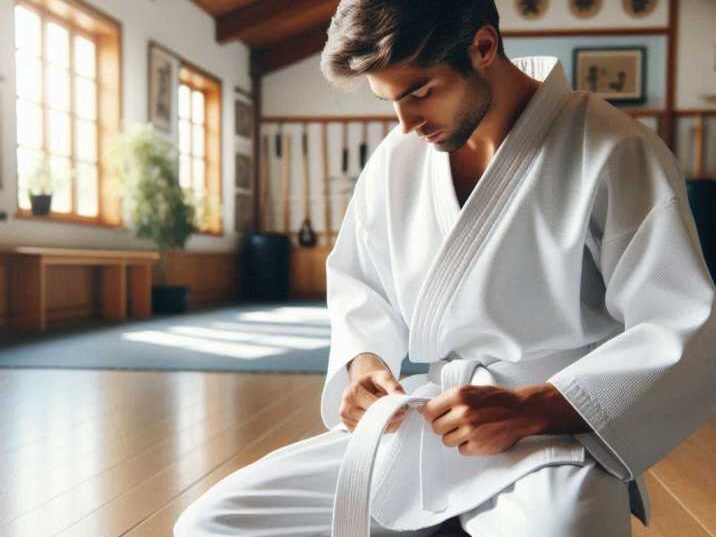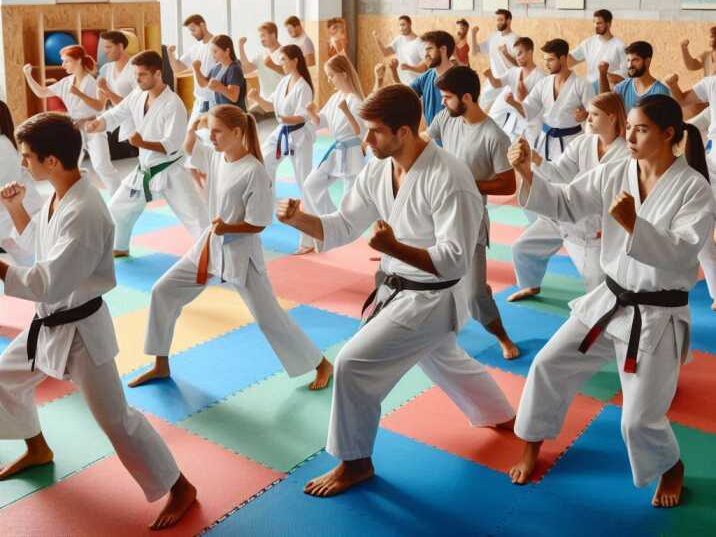Introduction
Table of Contents
Martial arts are more popular today than ever before. From fitness lovers to people seeking self-defense, beginners around the world are stepping into martial arts training. But with so many styles—Karate, Taekwondo, Boxing, Judo, and more—the big question is: Which is best martial art for beginners in 2025?
If you’re starting your martial arts journey, don’t worry. In this guide, we’ll break down the easiest martial arts to learn, their benefits, and how you can choose the right one for your goals.
Why Martial Arts Are Great for Beginners
Martial arts are not just about fighting. For beginners, they offer a wide range of benefits:
Fitness & Health
Martial arts training is a full-body workout that improves strength, stamina, and flexibility. Regular practice keeps you active, fit, and energetic. It’s a fun way to exercise without the boredom of routine workouts.
Confidence
Martial arts teach you to trust your own abilities. As you master new skills, your self-confidence naturally grows. This mental strength benefits every area of your life, from school to work to personal goals.
Self-Defense
Beginners learn simple but effective self-defense techniques. These skills give you the confidence to protect yourself in real-life situations. The purpose of martial arts isn’t to start fights—it’s to ensure your safety.
Discipline & Respect
Every martial art emphasizes discipline and respect. With consistent practice, you develop focus, patience, and self-control. These habits are not only useful in training but also in school, your career, and daily life.
Stress Relief
Training sessions release stress and anxiety. The combination of physical activity and mental focus relaxes the mind. Martial arts provide a healthy outlet that leaves you feeling positive and refreshed.
Top 7 Martial Arts for Beginners in 2025
1. Karate – Discipline & Basics
Karate is one of the simplest and most structured martial arts for beginners. It teaches punches, kicks, and defensive blocks that are easy to grasp. Suitable for both kids and adults, Karate builds self-discipline and focus. It provides a strong foundation that can help you progress into any other martial art later on.

2. Taekwondo – Fun Kicking Techniques
Originating from Korea, Taekwondo is world-famous for its fast and flashy kicks. This martial art improves agility, balance, and flexibility—making it especially appealing to kids and teens. With schools available worldwide, it’s easy for beginners to start. As an Olympic sport, it also provides extra motivation and recognition.
3. Judo – Throws & Balance
Judo is a grappling-based martial art that doesn’t rely on strikes. Instead, it focuses on throws, sweeps, and takedowns to control an opponent. For beginners, it’s a safe and gentle option since the goal isn’t to hurt but to gain control. Along the way, your balance and coordination improve naturally.

4. Muay Thai – Striking Made Simple
Known as the “Art of Eight Limbs,” Muay Thai uses punches, kicks, knees, and elbows in a unique combination. Its techniques are simple yet practical, making it highly effective for real-world self-defense. It also delivers an intense cardio workout, boosting stamina and overall fitness. For teens and adults, Muay Thai is an exciting and powerful choice.
5. Boxing – Best for Fitness
Boxing is one of the easiest martial arts for beginners of all ages. It focuses mainly on punching techniques and footwork, which quickly deliver fitness results. Regular boxing practice helps with weight loss, endurance, and confidence. With gyms and training centers available worldwide, it’s one of the most accessible martial arts.
6. Brazilian Jiu-Jitsu – Ground Control
Brazilian Jiu-Jitsu (BJJ) is a grappling martial art that specializes in ground fighting and submissions. It teaches beginners how to control opponents using technique instead of strength. BJJ is especially effective for smaller or physically weaker individuals. Training also develops patience, problem-solving, and mental sharpness.
7. Aikido – Gentle Self-Defense
Aikido is a Japanese martial art that focuses on harmony rather than aggression. It teaches how to use an opponent’s energy to redirect attacks instead of clashing with force. With a lower risk of injuries, Aikido is excellent for stress relief and inner peace. Beginners looking for a calm, non-aggressive martial art will find Aikido ideal.
How to Choose the Right Martial Art for You
Define Your Goal (Fitness, Self-Defense, Sport, or Discipline)
The first step is to be clear about your goal. If you want fitness and weight loss, Boxing or Muay Thai are great choices. For self-defense, BJJ and Judo are highly effective. If you’re interested in competition, Taekwondo and Karate are perfect. For discipline and focus, Aikido and Karate are excellent options.
Availability of Schools Near You
The availability of good schools and instructors matters a lot. Even the best martial art won’t help if you can’t find a qualified instructor nearby. Always check for certified dojos, academies, or gyms in your area. A good instructor ensures steady progress and keeps you motivated.
Age (Kids vs. Adults)
Age is another important factor. Young children often enjoy Karate and Taekwondo because of their simple and structured moves. Teenagers and adults may prefer Boxing, Muay Thai, or BJJ since they offer both fitness and self-defense. There’s always a martial art suitable for every age group.
Cost & Time Commitment
Martial arts are a long-term commitment. Class fees, uniforms (gi, gloves, pads), and membership costs vary by style. Choose a martial art that fits your budget and schedule. For example, Boxing gyms are usually more affordable, while BJJ and Muay Thai can be more expensive.
Beginner Tips & Mistakes to Avoid
Wear Comfortable Clothes
When starting martial arts, comfort is more important than style. Loose, breathable clothing allows you to move freely and prevents injuries caused by restricted movement. If your school provides a uniform (like a gi), invest in one to feel part of the group. Avoid jewelry or accessories that may get in the way.
Don’t Compare Yourself to Others
Every student learns at a different pace. Comparing yourself to advanced classmates can be discouraging. Instead, focus on your own progress—whether it’s mastering a stance or improving your balance. Remember, even black belts were once beginners. Celebrate small wins to stay motivated.
Stay Consistent
The key to improving in martial arts is showing up regularly. Missing classes slows down your progress and makes it harder to keep up. Even attending 2–3 sessions a week leads to big improvements in strength, focus, and technique. Consistency builds lasting habits.
Respect Your Instructor and Classmates
Martial arts are built on respect and discipline. Always bow to your instructor, follow directions carefully, and treat your classmates kindly. A respectful environment allows everyone to learn and grow together. The more respect you show, the more support you’ll receive in return.
Tip: Take a Free Trial Class Before Committing
Before making a final decision, attend a trial class. This helps you understand the instructor’s style, the class environment, and your comfort level. You may think Taekwondo is the best choice, but after a trial, you might find BJJ suits you better. Trial classes also boost confidence and make choosing easier.
Comparison Table: Best Martial Arts for Beginners in 2025
| Martial Art | Pros ✅ | Cons ❌ | Best For 🌟 |
|---|---|---|---|
| Karate | Easy to learn basics Builds discipline & focus Great for kids & adults | Limited ground defense Can feel repetitive | Children, families, and complete beginners |
| Taekwondo | Fun & dynamic kicks Improves flexibility & speed Olympic recognition | Less focus on punches Needs good flexibility | Kids, teens, and athletic beginners |
| Judo | Gentle but effective Great for self-defense without striking Enhances balance & coordination | No striking skills Can be tough on joints | Beginners who prefer grappling over punching |
| Muay Thai | Simple, powerful techniques Excellent cardio workout Highly practical for self-defense | Physically demanding Higher injury risk | Teens & adults seeking fitness + fighting skill |
| Boxing | Easy to start at any age Great for fitness & weight loss Widely available worldwide | Only focuses on punches No kicks or grappling | Anyone wanting fast fitness & confidence results |
| Brazilian Jiu-Jitsu | Relies on technique, not strength Highly effective for self-defense Builds patience & problem-solving | Steep learning curve Physically tiring ground game | Beginners who want self-defense without striking |
| Aikido | Low injury risk Focus on harmony & control Stress relief & personal growth | Less practical in real fights Limited schools | Adults seeking a calm, non-aggressive martial art |
Conclusion – Start Your Journey Today
Martial arts are for everyone—kids, adults, beginners, and even seniors. The best martial art for beginners in 2025 depends on your personal goals. Karate and taekwondo are great for children, boxing and Muay Thai suit fitness lovers, while BJJ and judo are excellent for self-defense.
No matter which one you choose, remember: the hardest step is the first step. Once you start, martial arts can change your life forever.
FAQs
1. What is the easiest martial art to learn for beginners?
Karate and boxing are considered the easiest to start.
2. Which martial art is best for self-defense?
Muay Thai and Brazilian Jiu-Jitsu are excellent for real-life self-defense.
3. Can I learn martial arts at any age?
Yes! Martial arts are for all ages—from kids to adults and even seniors.
4. I need to be fit before starting?
No—you don’t need to be fit before starting martial arts. Martial arts itself will help you build strength, stamina, and flexibility over time. Instructors are used to teaching beginners of all shapes and sizes, so you can start at your own pace and improve step by step.
5. Which martial art is best for women’s self-defense?
6. Brazilian Jiu-Jitsu (BJJ) is often recommended for women because it teaches how to escape from grabs and defend against larger opponents on the ground. Muay Thai and Krav Maga are also excellent, as they focus on practical strikes and real-life self-defense situations.
7. Can martial arts help with weight loss?
Yes—martial arts is a great way to lose weight while having fun. Styles like Muay Thai, Boxing, and Taekwondo burn a lot of calories through intense cardio workouts. Training also builds muscle, which increases metabolism and helps your body burn fat even at rest.


